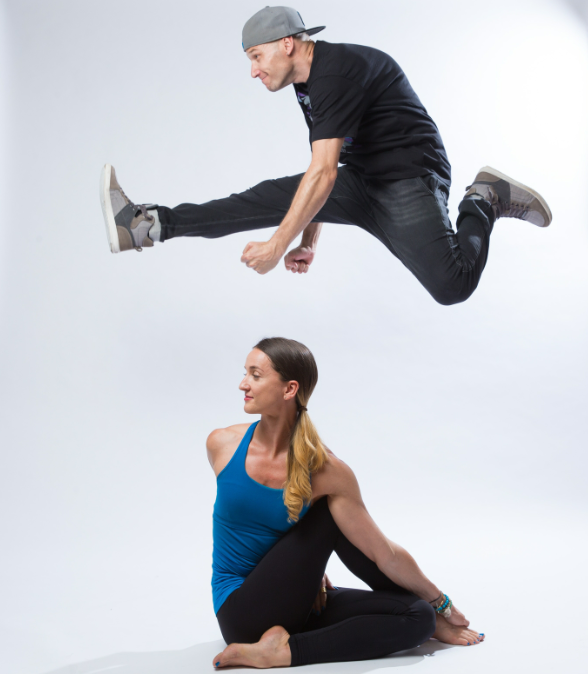
As long as I’ve been practicing yoga and as much as I believe in the power of a well-trained mind, I remain overly sensitive. Now, I don’t necessarily mean I’m overly emotional or prone to get my feelings hurt at the smallest probing (although I do have my moments!) but rather that certain senses are particularly heightened, specifically my hearing. I hear everything. I’m hyper attuned to any audio-stimuli: the slightest creaking of a radiator, or even the dull electric buzz of a speaker turned on but not emitting sound catch my attention and hold on.
One day last year I realized we must have a new downstairs neighbor. There I was on my mat: breathing and moving, when I heard the resounding blasts of exceptionally loud music vibrating up through the floor. Suddenly all of my attention was ripped out of my practice and focused on this noise! “How unfair,” I whined to myself, “how horrible!” I sulked around, complained to my husband, and stopped my practice early. When it happened the next week I felt my heart drop. After a few minutes of self-pity I thought about how I could help myself carry on. My solution? Earplugs.
All that noise got me thinking about distraction, which got my thinking about Pratyahara.
Our senses are the means through which we experience the world. How something looks, tastes, smells or feels gives us a multitude of information about the object and can definitely contribute to experiences of great and simple joys in this life: the honeyed taste of a ripe peach, the comforting smell of fresh brewed coffee, or the sudden, unexpected glimpse of the face of a loved-one.
I know I love it when my eyes fall upon a particularly beautiful display of fresh flowers, but like I mentioned, I’m hopelessly distracted by sounds, and I’m sure some of you can relate: perhaps you’re extra sensitive to bright lights, or, like my husband, hyper aware of smells.
The pull of the senses on our mind is undeniable: they show us the good, the bad, and the ugly, often with little warning. And naturally, whether we like it or not, our mind follows. This can lead not only to feelings of spontaneous joy and delight, but also to distraction, anxiety, a lack of focus, and an overall feeling of being out of control of things.
The fifth of the eight limbs of Patanjali’s classical path of Ashtanga Yoga is Pratyahara, commonly translated as “withdrawal of the senses.” While this translation is accurate, for me, a more precise description might be restraint of the senses, or conscious control, connection to, or mastery over the senses.
Now, there’s no doubt that the information we get from our senses is not limited to being either enjoyable or depressing, it can be downright vital! If you’re out in the world, you need your senses about you.
So what are we trying to accomplish when practicing Pratyahara?
My understanding of the fifth limb is that it’s placed specifically between what we might consider the external limbs of the eightfold path: yama, moral restrains and niyama, ethical observances – you can read my blog about them here; asana, posture, and pranayama, breath control, and the internal limbs that follow it: dharana, concentration, dhyana, meditation, and Samadhi, enlightenment. Using the yama and niyama as moral guidelines and practicing yoga postures and breathing exercises are things we can do. We can interact with them. It’s pretty clear if we’re engaged with them or not, and often, pretty easy to measure their effects on our life. Whereas concentration, meditation and enlightenment are often more ephemeral…sure we can sit down with the intention to meditate or to focus in on self-study, but without the limb in between, pratyahara, control of the senses, our success might not be guaranteed, and no amount of “doing” is going to help us gain enlightenment.
Throughout my years exploring yoga I’ve found that some of the best tools to practice reigning in the pull of the senses in order to more fully focus our conscious attention on the meditative and contemplative aspects of the practice are those of the Ashtanga Tristhana, or the or three pronged approach to focus. I use these guidelines during my own practice on the mat, when leading others in Ashtanga Vinyasa yoga, and even when I teach other styles of yoga asana classes. By constantly trying to fixate our attention on the breath, the gaze, or direction of the eyes, and a connection to the internal locks or bandhas (and sometimes therefore on the external form of the body or its alignment), we systematically train ourselves to reign in the senses. Instead of looking all over the place we look at one place. Instead of fidgeting or fixing our clothing we learn to stand still and simply feel in order to connect. This practice allows the possibility of a more internal study of the self, without the constant pull of external stimuli. How many times have you found yourself looking at someone else’s pose during a yoga class and being instantly taken out of yourself? Just a glimpse of another practitioner can induce a flood of internal dialogue: How is he doing that with his leg? Where did she learn that? How long have they been practicing?
One important thing I’ve begun to ask myself when thinking about reining in the senses is: is this information serving me? As a beginner to physical asana yoga practice, it’s often extremely useful to actually look at the shape of our bodies in order to understand where they are in space. For some it might even be useful, on occasion, to look at someone else do a posture to gain a glimpse of understanding. And similarly, listening to a teacher demonstrate the sound of the ujjayi breathing technique could clue us in to how we might create the sound. Visual and audio input is extremely useful tools in this stage!
But once we establish a steady practice, and more importantly, if we want that practice to lay the foundation of a deeper connection to the greater path of yoga, we must ask ourselves if these external stimuli are still serving us. Do we really need to visually double check the alignment of every single posture every single time? To fix our t-shirt before each pose? To watch others do more complicated postures on the mats next to us? Usually the answer is no; these things simply aren’t serving us anymore. And in the subtlety of that self-inquiry comes the opportunity to choose sensory withdrawal. The point is not that reacting to the pull of external stimuli is always wrong – but rather that we might learn something from practicing connecting to our senses without unconsciously reacting to them. The circumstances are never going to be perfect; your mat could always be a little straighter, your house could always be a little quieter, so how can we practice staking a step back from those pulls? Can we steady the eyes and practice the discipline of not glancing around the yoga room, or hone in deeply on the internal resonance of the sound each breath makes? Great lessons can be learned once the mind can be more directed around the pull of the senses…opportunities for meditative experiences, concentration, and the possibility of a full realization: we are not our thoughts, we are not our bodies, we are not our senses.
And perhaps in a similar way we can start to direct our attention more accurately and effectively outside the yoga studio and off of the mat, and maybe we won’t find our minds pulled by every single small external distraction.
And when all else fails…there are always earplugs!

